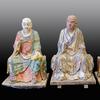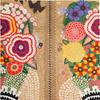WINTERTHUR ANNOUNCES NEW MAJOR EXHIBITION, COMMON DESTINATIONS: MAPS IN THE AMERICAN EXPERIENCE
- WINTERTHUR, Delaware
- /
- March 20, 2013
Journey through the centuries and learn how maps shaped the identity of an emerging America in Winterthur’s new major exhibition Common Destinations: Maps in the American Experience. Opening April 20, 2013, Common Destinations offers a fascinating voyage through the centuries that included the colonial wars, the American Revolution, and decades of nation building.
"Then, as today, America took pride in building unity out of diversity, and maps helped a fledgling nation forge common bonds and foster good citizenship,” said Dr. Martin Brückner, University of Delaware. “Visitors will see how men used maps at home and abroad; how women and children engaged with maps to nurture family ties; and how maps became the social glue that would bind a people of strangers into a community during times of change and development."
Brückner conceived and curated Common Destinations.
The exhibition features more than 100 items from the 1750s to the 1870s rarely seen in Winterthur’s collections, including traditional maps on paper and images of maps on objects including ceramics, playing cards, globes, puzzles, powder horns, fans, handkerchiefs, and more.
Current technology has transformed maps, once a stationary reference tool owned by an elite few, into a dynamic digital download accessible to everyone. Common Destinations seeks to engage visitors in contemplating how maps might have affected their daily life had they lived in early America.
Common Destinations reveals the compelling story of how America’s identity was inextricably linked with maps through six themes:
• Sociable Maps: Parlors and Pubs — Over the centuries, maps became popular conversation pieces that helped Americans debate current affairs or explore their knowledge of the world. Whether in homes, taverns, or coffee houses, maps were the perfect medium for dialogues, debates, games, and other social exchanges.
• Indoors/Outdoors: Men and Their Maps — Maps played a crucial role not only in the political and commercial activities of men but also in their personal lives. Maps shaped reading and writing trends and were a part of period-specific, routine outdoor activities, such as land-surveying, and traveling. At a time when social status was predicated on land ownership or commerce, maps were both practical navigational tools and esoteric status symbols for men.
• Maps in a Woman’s World — Maps were important to American women’s lives in many ways. Whether serving as teaching tools for home-schooled children, or providing needlework and embroidery themes for interior decoration, or functioning as fashionable accessories, maps became an intriguing source of information and entertainment for women and children.
• Before the Revolution: Science, Pictures, and Baroque Maps — In the 18th century, the aesthetics of maps became just as important as the accuracy of the geography. Designs were borrowed from baroque furniture, emblem books, and even theater sets.
• The National Map: 1784–1815 — Building a sense of community among a young nation that spent decades with political uncertainty was one of the biggest contributions of maps after the Revolutionary War. They no longer were imported from abroad but were replaced with first-generation domestic maps that illustrated national unity and became part of the school curriculum to help build a new society.
• Maps and Masses: Cartography in the Industrial Age — The application of machine-made paper and lithography during the 1830s made maps a highly diversified commodity as they were tailored to meet the needs of national and international audiences. With mass production, map ownership became almost universal and for the first time, entered window displays in shopping districts and became a staple at national and international fairs.
EXHIBITION-RELATED EVENTS AT WINTERTHUR
Common Destinations features a host of related events designed to entertain, engage, and educate visitors, including lectures, a conference, a teacher workshop, special Members-only functions, group tours, and more, including:
Opening Celebration, April 18, 5:30 – 8:00 pm. Winterthur Director David Roselle will host Contributor-level-and-above Winterthur Members for a private viewing and cocktail reception celebrating this fascinating exhibition. By invitation only. Please call 302.888.4713 to become a Winterthur Contributor.
Member Preview Day, April 19, Noon – 7:00 pm. Members may view the exhibition prior to its public opening. Guided Gallery Walks throughout the day. Free to Members and guests with passes.
Lunchtime Lecture Series. Special, topically relevant lectures scheduled April through December.
Family Programs on Saturdays, 1:00 – 3:00 pm. Exciting programs that will include Winterthur’s popular Hands on History Cart among other attractions exploring themes of the exhibition.
Teacher Workshop, October 5, 9:30 am – 12:30 pm. This workshop offers active teachers an in-depth look at the exhibition plus ideas about how to use maps in the classroom. Registration required. Cost: $15.00.
Winterthur Conference. “Common Destinations: Maps in the American Experience,” October 11 – 12. This two-day conference will feature lectures, workshops, and gallery tours.
For more information, please visit winterthur.org, or call 302.888.4600.
Presented By:
This exhibition is supported in part by an award from the National Endowment for the Arts and with additional support from Potter Anderson & Corroon LLP and Office of the Provost at the University of Delaware










_-Closing-the-Distance_100x100_c.jpg)





